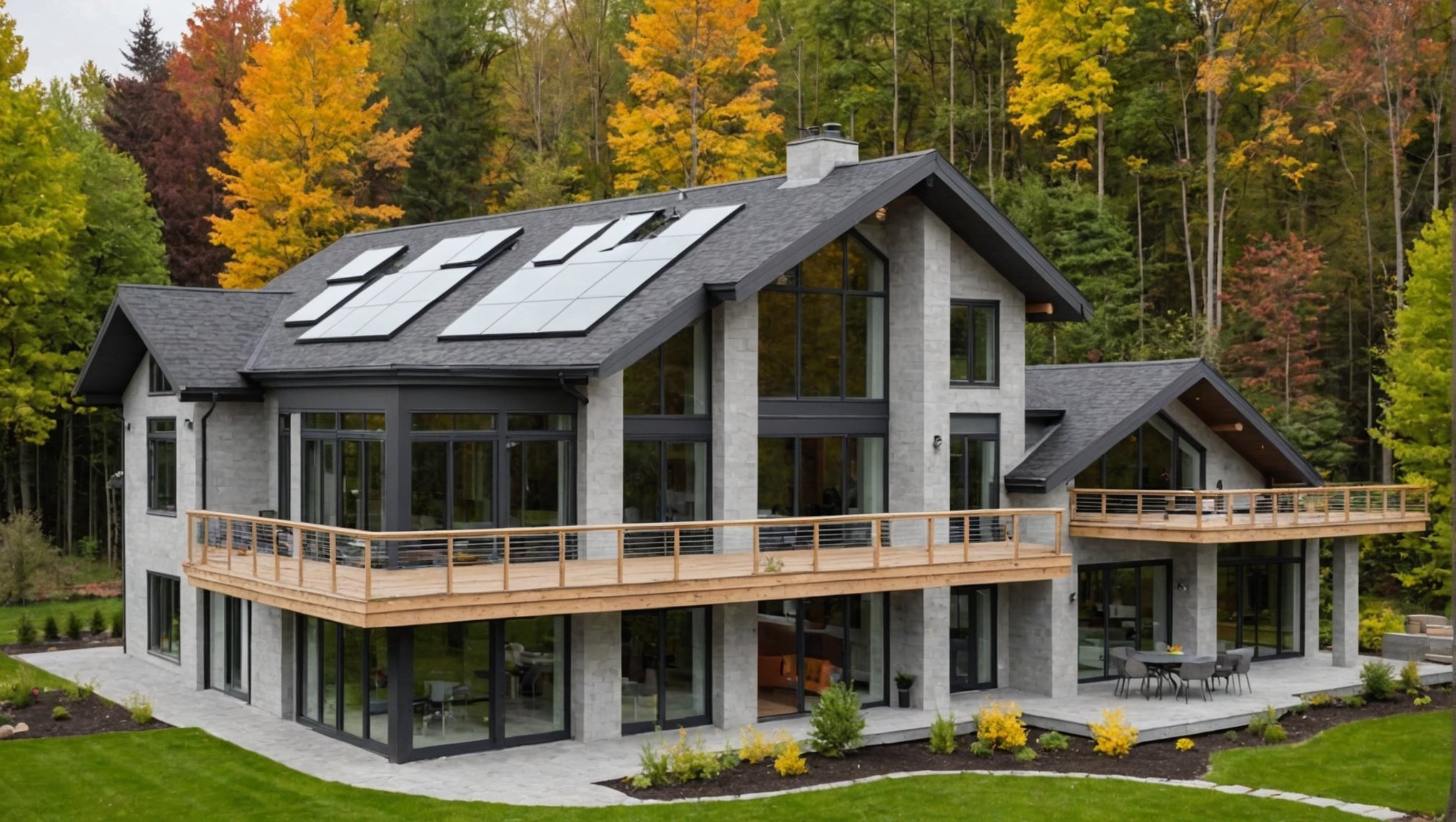Overview of Eco-Friendly Materials
Eco-friendly construction materials have become increasingly crucial in shaping sustainable building practices. They play a significant role in reducing the environmental impact of construction projects. By choosing sustainable building options, individuals and companies aim to lower carbon footprints and support ecological balance.
The importance of such materials cannot be understated. Traditional construction materials often contribute to pollution and excessive waste, whereas eco-friendly alternatives focus on utilizing resources that are renewable, recyclable, and non-toxic. This makes them a cornerstone for building responsibly and efficiently.
Additional reading : Unlocking Brilliance: Ingenious Strategies to Enhance Natural Light in Your Basement Art Studio
Among the benefits of using sustainable materials for home additions is the reduction in energy consumption. These materials often provide better insulation, helping maintain indoor temperatures and decreasing reliance on artificial heating and cooling. Additionally, they usually lead to improved air quality, as they emit fewer harmful chemicals.
There are numerous popular eco-friendly materials available in today’s market. For instance, bamboo is extensively used due to its rapid growth rate and durability. Recycled steel reduces the need for mining new resources, while sheep’s wool offers excellent insulation properties. By integrating these options into residential and commercial projects, we can move towards a brighter, greener future.
In the same genre : Top Drawer Organizer Styles Perfectly Complementing Classic Shaker Kitchen Designs
Types of Eco-Friendly Materials
When considering eco-friendly materials, it’s essential to understand the array of options available. They not only enhance our living spaces but make a positive environmental impact.
Recycled Materials
Recycled materials are pivotal in reducing waste. By repurposing resources, they prevent new materials from being harvested. Common examples include recycled steel and glass, both of which provide durability. This process requires less energy than producing materials from raw sources. Successful implementations include skyscrapers using recycled steel in their frameworks. They demonstrate impressive results both in structural integrity and reduced carbon footprint.
Bamboo
Known as a rapid-growing plant, bamboo is a staple in green building materials. Its strength rivals that of concrete, and it can regenerate swiftly without requiring replanting. Bamboo’s case studies are widespread, especially in tropical climates where its natural abundance is beneficial. Its utility ranges from flooring to scaffolding, reducing the need for deforestation.
Hempcrete
Hempcrete is an innovative material made from hemp fibers mixed with lime. This composite not only acts as a superior insulator but is also noted for its carbon absorption capabilities. Buildings using hempcrete showcase reduced energy consumption. Implementations, such as in European homes, demonstrate its effectiveness in maintaining efficient thermal regulation. Hemp’s rapid growth ensures sustainability, providing a renewable building resource.
Benefits of Using Eco-Friendly Materials
Adopting eco-friendly construction practices provides several substantial advantages. One significant benefit is energy efficiency, leading to long-term cost savings. By integrating sustainable building techniques, structures are designed to reduce energy consumption, thus lowering utility bills over time.
Another compelling advantage of sustainable building is the positive impact on residents’ health. Eco-friendly materials often minimize the presence of harmful chemicals and allergens, fostering a healthier living environment. Reduced exposure to volatile organic compounds and other pollutants enhances indoor air quality, contributing to overall well-being.
Moreover, eco-friendly construction methods play a critical role in reducing the environmental impact. These practices aim to minimize waste and preserve natural resources, thereby mitigating biodiversity loss. For instance, using recycled materials and adopting sustainable forestry practices help conserve wildlife habitats and reduce carbon emissions.
Lastly, the contribution to sustainable development cannot be overlooked. Buildings designed with sustainability in mind promote responsible growth and align with global efforts to address environmental challenges. By prioritizing eco-friendly materials, construction projects can support a balanced ecosystem and ensure resources remain available for future generations. Embracing these practices not only benefits individual projects but also plays a part in the broader commitment to protecting our planet.
Cost Considerations for Eco-Friendly Materials
When focusing on the cost of eco-friendly building materials, it’s important to weigh initial expenses against long-term savings. Although sustainable materials may require a larger upfront investment, they can lead to significant reductions in energy bills and maintenance costs over time. This makes sustainable construction a potentially cost-effective option in the long run.
Sustainable construction budgeting is more manageable when taking advantage of available financial incentives. Governments and organizations often offer tax credits and grants for projects that utilize eco-friendly building materials, which can substantially reduce the overall cost. These incentives are designed to encourage the adoption of sustainable practices and lessen the financial burden on developers.
For those looking to maintain a strict budget, choosing cost-effective eco-friendly material options can make a substantial difference. Options such as recycled or reclaimed materials not only help in reducing costs but also lessen environmental impact. Furthermore, incorporating locally sourced materials can minimize transportation expenses while supporting local economies.
Understanding these factors enables builders and homeowners to make informed decisions, balancing financial constraints with the desire to implement sustainable practices. Embracing eco-friendly materials is not only beneficial for the planet but can also be smart economically over time.
Practical Tips for Implementing Eco-Friendly Materials
Integrating eco-friendly materials into your home requires thoughtful sourcing and selection. Opt for certified sustainable products, such as FSC-certified wood, which ensures responsible forest management. Similarly, bamboo flooring is a fast-growing alternative to traditional hardwood. When choosing paints or finishes, look for labels that indicate low Volatile Organic Compounds (VOCs), reducing harmful emissions.
Collaborating with experienced contractors is essential for successful sustainable renovations. Seek professionals who have a proven track record in green building practices. This not only ensures adherence to sustainable standards but also provides peace of mind that your project aligns with eco-friendly principles. Discuss your goals early in the planning phase to ensure everyone is on the same page.
To maintain the benefits of eco-friendly materials, adopt proactive maintenance strategies. Regular cleaning with non-toxic, biodegradable products will keep surfaces in good shape without compromising their integrity. For materials like bamboo, use protective mats in high-traffic areas and keep them away from direct sunlight to prevent fading.
By implementing these strategies, you embrace more sustainable renovation practices. This not only lessens your environmental footprint but also enhances your home’s durability and aesthetic appeal.
Case Studies and Success Stories
In the quest for eco-friendly renovations, success stories abound, showing us how sustainable practices can be woven into our lives. These case studies highlight the positive impact and benefits of choosing eco-friendly options.
Residential Home Additions
When homeowners opt for sustainable building projects, their success stories inspire others. Consider a family who incorporated recycled materials and energy-efficient designs into their home addition. The result was not only an environmentally friendly space but also a reduction in energy costs. These transformations align with eco-friendly renovations by emphasizing both aesthetics and sustainability. Homeowners can enjoy modern features while minimizing their carbon footprint.
Community Projects
The power of sustainable building projects is often multiplied in community settings. For instance, a neighbourhood that renovates its public spaces using eco-friendly practices often experiences enhanced community pride and increased environmental awareness. Such projects can also lead to economic benefits, with reduced operational costs and increased resilience to environmental changes. These case studies serve as blueprints for other communities aiming to embrace sustainable living.
Innovative Uses of Eco-Friendly Materials
Exploring new ideas in eco-friendly renovations often leads to innovative solutions. The introduction of versatile materials like bamboo or recycled composites in construction allows projects to be both inventive and sustainable. These success stories encourage creativity, pushing the boundaries of traditional building materials while contributing to environmental sustainability.











